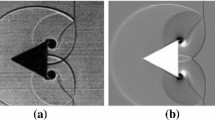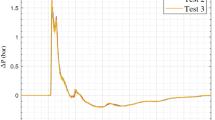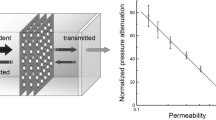Abstract
The interaction of weak shock waves with porous barriers of different geometries and porosities is examined. Installing a barrier inside the shock tube test section will cause the development of the following wave pattern upon a head-on collision between the incident shock wave and the barrier: a reflected shock from the barrier and a transmitted shock propagating towards the shock tube end wall. Once the transmitted shock wave reaches the end wall it is reflected back towards the barrier. This is the beginning of multiple reflections between the barrier and the end wall. This full cycle of shock reflections/interactions resulting from the incident shock wave collision with the barrier can be studied in a single shock tube test. A one-dimensional (1D), inviscid flow model was proposed for simulating the flow resulting from the initial collision of the incident shock wave with the barrier. Fairly good agreement is found between experimental findings and simulations based on a 1D flow model. Based on obtained numerical and experimental findings an optimal design procedure for shock wave attenuator is suggested. The suggested attenuator may ensure the safety of the shelter’s ventilation systems.
Similar content being viewed by others
References
Dosanjh D.S. Interaction of grids with traveling shock waves. NACA TN 3680 (1956)
Franks, W.J.: Interaction of a shock wave with a wire screen. UTIA Tech. Note No. 13 (1957)
Barthel, H.O.: On a mechanism for the interaction of plane traveling shock waves striking rigid grid-like structures head-on. In: Fifth Midwestern Conference of Fluid Mech, University Michigan, USA (1957)
Abdel-Ghany S.M., Horlock J.H. (1966) Some experiments on steady and unsteady flow of air through wire gauzes. Int. J. Mech. Sci. 8, 491–507
Lind C., Cybyk B.Z., Boris J.P. (1999) Attenuation of shocks: high Reynolds number porous flows. In: Ball G., Hillier R., Roberts G.T. (eds) Proceedings of 22nd International Symposium on Shock Waves, Imperial College, London, England, pp 11.35–11.40
Gelfand B.E., Medvedev S.P., Polenov A.N., Frolov S.M. (1987) Interaction of non-stationary pressure waves with perforated partitions. Arch. Combust. 7, 215–222
Keller J., Merzkirch W. (1990) Interaction of normal shock with a compressible turbulent flow. Exp. Fluids 8, 241–248
Honkan A., Andreopoulos J. (1992) Rapid compression of grid-generated turbulence by a moving shock wave. Phys. Fluids A4, 2562–2572
Honkan A., Watkins C.B., Andreopoulos J. (1994) Experimental study of interactions of shock wave with free-stream turbulence. Trans. ASME J. Fluid Eng. 116, 763–768
Britan A., Karpov A.V., Vasiliev E.I., Igra O., Ben-Dor G., Shapiro E. (2004) Experimental and numerical study of shock wave interaction with perforated plates. ASME J. Fluids Eng. 126, 399–409
Nurick H.N. (1976) Orifice cavitation and its effect on spray mixing. Trans. ASME J. Fluid Eng. 98, 681–687
Ramamurthi K., Patnaik S.R. (2002) Influence of periodic disturbances on inception of cavitation in sharp-edges orifices. Exp. Fluids 33, 720–727
Britan A., Ben-Dor G., Igra O., Shapiro H. (2001) Shock waves attenuation by granular filters. Int. J. Multiph. Flow 27, 617–634
Amann H.O. (1969) Experimental study of the starting process in a reflection nozzle. Phys. Fluids 12, 150–153
Britan A., Gilin Yu., Mazmaniantc A. (1979) Experimental study of the wedged nozzle start-up in the large diameter shock tube (in Russian). J. Fluid Dyn. USSR 6, 152–156
Britan A., Vasiliev E. (1985) Flow formation in the profiling nozzle of shock tube (in Russian). Dokl. Akad. Nauk USSR. 281(2): 295–299
Prodromou, P., Hiller, R.: Computation of unsteady nozzle flows. In: Proceedings of 18th International Symposium on shock waves, vol. II, 1113–1119, Sendai, Japan (1985)
Tokarcik-Polsky S., Cambier J.L. (1994) Numerical study of transient flow phenomena in shock tunnels. AIAA J. 32(5): 971–978
Chue, R.S.M., Eitelberg, G., Carl, M.: Transient starting process in the HEG nozzle. In: Proceedings of 21st International Symposium on shock waves, Paper 3098, Great Keppel, Australia (1997)
Igra O., Wang J., Amann O. (1998) Simulation of the starting flow in a wedge-like nozzle. Int. J. Shock Waves 8, 235–242
Saito T., Takayama K. (1999) Numerical simulation of nozzle starting process. Shock Waves J. 9, 73–79
Amann H.O., (1973) Reichenbach.: Unsteady flow phenomena in shock tube nozzles In: Bershader D., Griffith W. (eds) Recent Development in Shock Tube Research. Stanford University Press, Stanford, pp 96–112
Smith C.E. (1966) The starting process in a hypersonic nozzle. J. Fluid Mech. 24(4): 625–640
Mirels H., Mullen J.F. (1964) Small perturbation theory for attenuation and nonuniformity. Phys. Fluids 7(9): 1208–1218
Khotin, V.G.: Application of explosive. Part 1. Physics of explosion (in Russian). Mendeleev Institute of Chemical Technology, Moscow (1969)
Author information
Authors and Affiliations
Corresponding author
Additional information
Communicated by O. Igra.
Rights and permissions
About this article
Cite this article
Britan, A., Igra, O., Ben-Dor, G. et al. Shock wave attenuation by grids and orifice plates. Shock Waves 16, 1–15 (2006). https://doi.org/10.1007/s00193-006-0019-0
Received:
Accepted:
Published:
Issue Date:
DOI: https://doi.org/10.1007/s00193-006-0019-0




